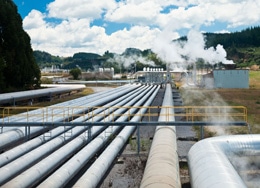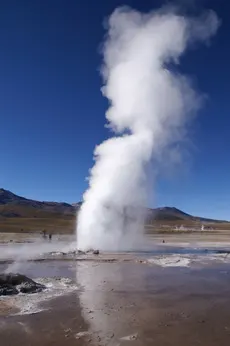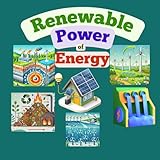
How Geothermal Energy Works
Geothermal Energy is Heating from the Earth’s Core
![]() How does geothermal energy work. Geothermal energy is another type of renewable energy resource that makes use of the large amounts of energy stored as heat in the water deep below the Earth’s surface. But to know how geothermal energy works, we need to understand where the heat comes from.
How does geothermal energy work. Geothermal energy is another type of renewable energy resource that makes use of the large amounts of energy stored as heat in the water deep below the Earth’s surface. But to know how geothermal energy works, we need to understand where the heat comes from.
The most prominent and visual example of this coming from “Geysers” and “Hot Springs” ejecting large columns of very hot water, steam and gases high up into the air. In fact the word “Geothermal” comes from combining together the two Greek words of Geo, meaning “Earth”, and Therme, meaning “heat”, with the resulting word “Geothermal” actually meaning “the heat generated from the Earth”. Then the expression “Geothermal Energy” literally means “heat energy generated from the Earth”.
Geothermal energy is obtained by extracting the available heat source which exists in the hot areas under the surface of the earth and which remain at a relatively constant temperature all year around day and night. Once available, geothermal energy can be used either directly or indirectly as an alternative energy resource to both heat or cool our homes.

This naturally occurring and free energy is extracted by a series of pipes filled with water buried below the Earth’s surface. This hot geothermal water is then used in our homes for heating, called Geothermal Heating, or to generate electricity, called Geothermal Power.
How Geothermal Energy Works
So how geothermal energy works to provide us with heat. Down at the Earth’s core, some 4000 miles below its surface, temperatures can reach well over 9000 degrees Fahrenheit, which is pretty hot. This incredible amount of heat originated four billion years ago in a fiery combustion of dust and gas as the Earth was first being created.
Many scientists believe that radioactive decay of the inner core keeps the heat regenerating and flowing outward from this inner core to the mantle of harder rock which surrounds it. When the temperature and pressure is high enough, some of this mantle rock melts. Then, because the melted rock or magma is less dense than the surrounding rock, it rises and moves slowly up towards the Earth’s crust.
Sometimes due to pressure and the force of more magma pushing from below, the hot magma reaches all the way to the Earth’s surface as a volcanic eruption. The majority of the time the magma just remains underground and heats the adjoining rock as well as any water that has seeped down through geologic holes, cracks and faults in the Earth’s crust absorbing the heat as it travels through these hot rocks.
Some of this water, whose temperatures can reach as high as 700 degrees, travels back up through cracks to the Earth’s surface and emerges as hot springs, geysers or pools of boiling mud. Far more often, the water and magma becomes trapped within the rock, forming a natural underground geothermal reservoir. It is these underground geothermal reservoirs that are able to give us another type of alternative energy resource with incredible potential.
Let us understand that geothermal is NOT mining, as mining removes the mined material forever, it is extraction of the heat from a hydrothermal fluid which is replenished, sometimes over very long periods by the Earth itself. This geothermal energy resources can be used either for direct consumption, heating or for power generation in one of the following three main ways:
The Types of Geothermal Energy Available
- Direct Geothermal Energy – this is where the hot water is available either on or very close to the Earth’s surface and can be used directly for heating, bathing or washing.
- Ground Source Geothermal – this is where the geothermally heated water is underground, but not too deep allowing for easy access to it using heat absorbing pipes or bore holes.
- Geothermal Power Plants – these harnesses the extremely hot water or steam using vertical bore holes drilled deep underground and then uses the available super heated geothermal water and steam to generate electricity.
For domestic applications, one way of extracting this heat energy is by the use of geothermal heat pump technology. The geothermal heat pump doesn’t create electricity, instead it circulates a thermally conductive liquid mixed with water through long pipes called an Earth loop buried up to 12 feet underground, operating on the same principle as the domestic refrigerator but in reverse.
A Geothermal Heat Pump, also known as a “Ground Source Heat Pump”, is a very efficient way to heat and air-condition our homes and buildings as it can move heat in both ways.
For example, during the colder winter months, low temperature heat is withdrawn from the ground (the heat source) for direct use in heating buildings and other structures.
In the hotter summer months, the geothermal heat pump operates in reverse removing the heat from the building and dissipating it back into the ground by acting as a large underground radiator.
As a result of this simple process, direct use geothermal heating is becoming very popular for the home owner because it provides a cost-effective alternative to expensive oil or gas home heating systems. One of the advantages of using geothermal energy for the home is that the energy savings using a ground source heat pump can be substantial over a long period of time.
Geothermal Power on the other hand uses extremely hot water heated by the underground magmatic activity which is pumped to the surface through geothermal wells and used for electricity generation. Once this super heated water reaches atmospheric pressure it turns to steam where it is used to operate steam-powered turbines and generators. Geothermal power plants are becoming more common in volcanic areas and countries such as Iceland and New Zealand, were it has the potential to produce over a quarter of their energy needs.
The main advantages of geothermal energy is that it is clean, cheap, no additional fuel is needed resulting in no greenhouse gases or air pollution. However, some disadvantages with geothermal include ground water and waste water pollution, geographically restricted and high maintenance costs. But the biggest disadvantage is that the closer you put a Geothermal power plant to an active volcano or heat source, the larger the potential operational problems you can have.
To gain a better understanding of how “Geothermal Energy” works, to obtain more information about the various geothermal energy systems available, or to explore the advantages and disadvantages of geothermal energy, then Click Here to order your copy from Amazon today and learn more about Geothermal Energy and installing Geothermal Heat Pumps in your home to save money and the environment.










Like!! Thank you for publishing this awesome article.
Hi, I would like to know if a geothermal heat pump that can operate bellow -7degC like entering water temperature exists ? If yes, where can I find it ?
I’ve been researching the process of geothermal heating, but have a few questions I haven’t been able to find good answers to. The fluid coming out of the ground will be about 50 degrees, how do you raise that to comfortable temperatures for home heating? Does it need a compressor? I thought it only used a heat pump. What exactly does the heat pump do? Does it only pump the fluid or does it also compress it? Any help here would be greatly appreciated.
Interesting article. Geothermal heating is good for heating water or air without spending much, but initial investment is required.